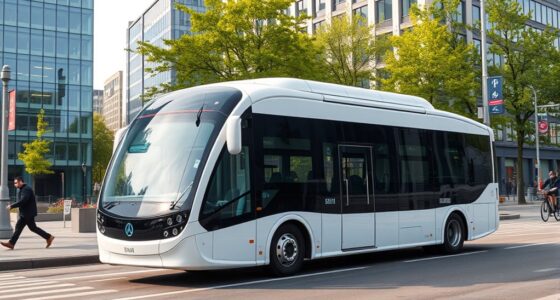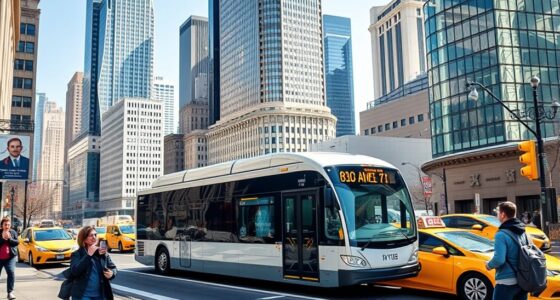Globally, pilot tests of solid-state batteries in electric buses are making promising progress. These trials focus on improving battery safety, performance, and charging times, aiming to revolutionize public transit. Many regions are overcoming manufacturing challenges by developing reliable electrolytes and establishing safety standards. If these efforts continue smoothly, they could lead to safer, more efficient, and eco-friendly buses worldwide. Keep exploring to discover how these innovations could transform transportation systems everywhere.
Key Takeaways
- Multiple regions are conducting pilot programs to evaluate solid-state battery performance in electric buses.
- Trials focus on assessing safety, charging times, longevity, and operational efficiency of solid-state batteries.
- Manufacturers collaborate with regulators to develop safety standards and certification processes during these trials.
- Early testing aims to identify manufacturing challenges and improve scalability for large-scale deployment.
- Successful global trials could accelerate adoption of solid-state batteries, transforming public transit systems worldwide.

As cities seek more sustainable transportation options, pilot testing solid-state batteries in electric buses offers a promising solution. These advanced batteries hold the potential to revolutionize public transit by providing higher energy density, faster charging times, and improved longevity. However, integrating solid-state technology isn’t without its hurdles. One of the main concerns is battery safety. Unlike traditional lithium-ion batteries, which use liquid electrolytes that can pose fire risks, solid-state batteries employ solid electrolytes that substantially reduce the chances of thermal runaway. This safety advantage makes them highly attractive for large-scale transportation, where safety is paramount. Despite these benefits, ensuring consistent safety standards during manufacturing remains a vital challenge. Producing solid electrolytes that are both stable and scalable can be complex, often requiring precise manufacturing conditions and advanced materials. Variations in production processes can lead to inconsistencies in battery performance, which manufacturers must address before widespread deployment. Additionally, regulatory standards are still evolving to keep pace with this emerging technology, making collaboration with authorities essential. As you explore the global trials underway, you’ll notice that different regions are approaching these manufacturing challenges with innovative solutions. Some companies are investing heavily in research to develop more reliable and cost-effective solid electrolytes, aiming to streamline the production process. Others are testing prototypes rigorously to identify safety issues early on, ensuring that the batteries perform reliably under real-world conditions. These efforts are essential because any safety concern or manufacturing flaw could delay or derail large-scale adoption. You’ll also find that manufacturers are working closely with regulatory bodies to establish safety standards and certification processes, helping to build public trust in this new technology. The shift to solid-state batteries in electric buses isn’t just about technological innovation; it’s about overcoming practical barriers. While the promise of longer-lasting, safer batteries is clear, the manufacturing challenges—such as ensuring uniform quality and scaling production—must be addressed to make these batteries viable on a mass scale. As you follow these global trials, you’ll observe that progress relies on collaborative efforts among engineers, researchers, and policymakers. Success in this arena could mean more reliable, safer, and environmentally friendly public transit options in the near future. Yet, the journey from lab prototypes to city streets remains filled with hurdles that require persistent innovation and meticulous manufacturing practices. Only by tackling these challenges head-on can solid-state batteries fulfill their potential to transform electric bus fleets worldwide.
Frequently Asked Questions
What Are the Main Safety Concerns With Solid-State Batteries?
You should be aware that solid-state batteries pose safety concerns mainly related to fire risk and thermal stability. Although they’re generally safer than liquid electrolyte batteries, thermal runaway can still occur if they overheat or get damaged. Ensuring proper thermal management and rigorous safety testing helps prevent potential fires. Staying vigilant about these risks allows you to better handle and deploy solid-state batteries safely in electric buses.
How Do Solid-State Batteries Perform in Extreme Weather Conditions?
You’ll find that solid-state batteries generally perform well in extreme weather conditions due to their thermal resilience and temperature stability. They resist overheating and don’t degrade as quickly in cold temperatures, making them reliable in diverse climates. However, extreme heat can still pose challenges, potentially affecting their longevity. Overall, their robust thermal properties help guarantee consistent performance, even during temperature fluctuations, making them suitable for global electric bus applications.
What Is the Expected Lifespan of Solid-State Batteries in Buses?
You can expect solid-state batteries in buses to last around 10-15 years, depending on usage. They typically experience less battery degradation over time compared to traditional batteries, which enhances their longevity. Manufacturers usually offer warranties of 8-10 years, reflecting confidence in their durability. Proper maintenance and operating conditions can extend their lifespan, ensuring you get the most value and reliability from your electric bus fleet.
Are Solid-State Batteries Recyclable or Environmentally Friendly?
Solid-state batteries are generally more environmentally friendly than traditional lithium-ion ones because their recycling processes are simpler and produce less waste. You can recycle their components, reducing environmental impact, and recover valuable materials like lithium and cobalt. While the technology is still evolving, these batteries tend to have a lower environmental footprint, making them a better choice for sustainable transportation. Proper recycling practices are essential for maximizing their eco-friendly benefits.
How Do Costs Compare Between Solid-State and Traditional Lithium-Ion Batteries?
You’ll find that the cost comparison favors traditional lithium-ion batteries overall, mainly because solid-state batteries currently face higher manufacturing challenges. These challenges increase production costs due to complex materials and processes, making solid-state options more expensive upfront. However, as technology advances and economies of scale kick in, the costs are expected to decrease, potentially making solid-state batteries more competitive in the future.
Conclusion
As these global trials take flight, you’re witnessing the dawn of a new era in electric bus technology. Solid-state batteries promise to be the sturdy backbone supporting cleaner, longer journeys. Like a lighthouse guiding ships through foggy waters, these innovations illuminate a path toward sustainable transportation. With each test, you’re helping shape a future where cities breathe easier, and roads become arteries of progress—fueling hope that these batteries will power a brighter, greener tomorrow.









